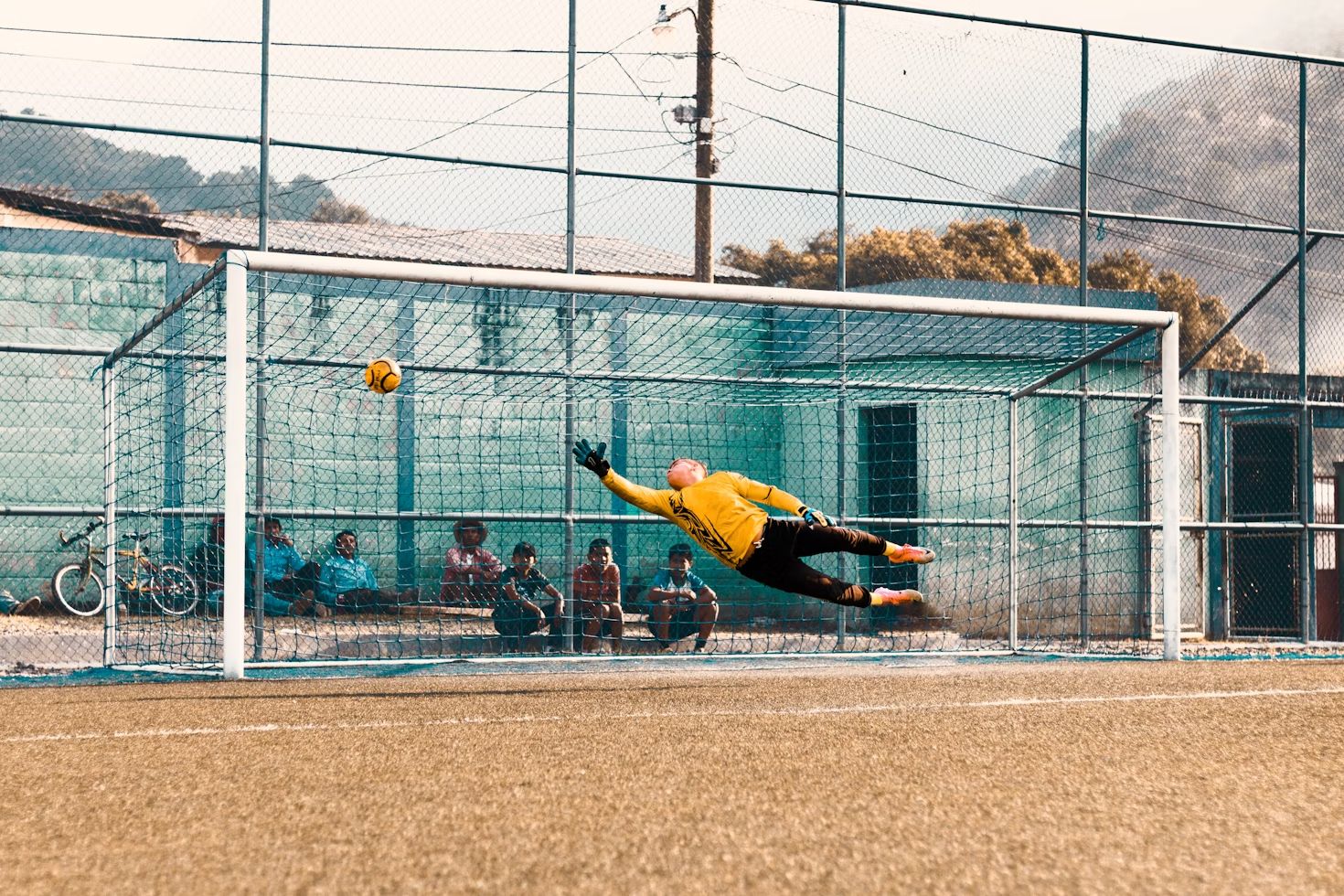The ease of playing a certain position in football can vary depending on individual strengths and preferences. Some positions need less technical skill or physical demands compared to others. However, the following positions are considered easier to play:
READ ALSO: What Does “MP” Mean In Soccer?
- Goalkeeper
- Defensive Midfielder
- Center Back
- Striker
- Winger
1. Goalkeeper

The role of goalkeeper is often considered one of the easiest positions to play. This is because the responsibilities of a goalkeeper are more focused compared to other positions.
To begin, the goalkeeper’s main job is to stop the opposing team from scoring goals. While outfield players must possess different skills such as dribbling, passing, and shooting, goalkeepers mainly focus on blocking shots and catching or deflecting balls.
This specialized role means that goalkeepers can devote their training time to mastering specific techniques related to goalkeeping.
Also, the physical demands placed on goalkeepers may be less compared to outfield players. While goalkeepers still need agility, reflexes, and strength to perform well, they generally cover less ground during a match than outfield players.
This can reduce the overall physical exertion required, making it a more manageable position for some players. Additionally, goalkeepers have a unique advantage when it comes to handling the ball.
Far from outfield players who cannot use their hands, goalkeepers are allowed to use their hands within the penalty area.
They have greater control over the ball, as they can catch or pick it up to stop play and restart the game with a throw or kick. This ability gives goalkeepers control and influence over the game that other players do not have.
2. Defensive Midfielder

The role of a defensive midfielder is to protect the defense line. They act as a barrier, intercepting passes, and breaking down the opponent’s attacks.
This involves tracking back when the opposing team has possession, closing down spaces, and applying pressure to regain the ball.
Defensive midfielders also play a key role in distributing the ball. They are the link between defense and attack, receiving passes from the backline and initiating attacks by distributing the ball to more advanced teammates.
Their ability to read the game and make accurate passes is essential for maintaining possession and creating scoring opportunities. One of the reasons why playing as a defensive midfielder is thought easier is the emphasis on tactical awareness.
Far apart from attacking positions that require dribbling skills or goal-scoring abilities, defensive midfielders rely more on intelligence and positioning.
Understanding when to press, when to hold back, and how to anticipate the opponent’s moves are crucial aspects of this role.
While physicality is important in soccer, defensive midfielders don’t necessarily need exceptional speed or strength like wingers or center forwards.
Instead, they need good stamina to cover large areas of the pitch and resilience to engage in physical battles when necessary.
However, their success is more dependent on mental sharpness and decision-making rather than purely physical prowess.
READ ALSO: What Does “CAM” Mean In Football?
3. Center Back

The center-back position is deemed one of the easiest positions to play, but it demands specific skills and responsibilities.
Center-backs are crucial defenders who play in the central area of the field, just in front of the goalkeeper. Their primary job is to stop the opposing team from scoring goals by intercepting passes, blocking shots, and maintaining a strong defensive line.
One of the reasons why center back is considered easy compared to other positions is because it doesn’t require as much running or agility as positions like midfielder or winger.
Center backs typically cover a smaller area of the field, allowing them to focus on their defensive duties without needing exceptional speed.
Another aspect that makes center-back easier for some players is that it relies heavily on positional awareness and reading the game.
Successful center backs anticipate the movements of opposing attackers, position themselves effectively to block passing lanes and shots and communicate with their teammates to maintain defensive organization.
This aspect of the position can be learned through experience and practice rather than relying solely on natural athleticism. Also, center backs often have less pressure to contribute to attacking play compared to other positions.
While they may occasionally join the attack during set pieces or when the team is dominating possession, their focus remains on defending and preventing goals.
This can relieve some of the tension that attacking players may feel to create scoring opportunities or score goals. However, despite being considered one of the easiest positions to play, center backs still require certain fundamental skills to impress.
These include strong tackling ability, aerial prowess to win headers, good decision-making under pressure, and effective communication with teammates.
Then again, center-backs must be calm and composed especially when facing skilled attackers or in high-pressure situations.
4. Striker

45.3% of fans voted the striking position as one of the easiest roles to play In football. Strikers have a clear objective that doesn’t involve vast tactical responsibilities.
The essential duty of a striker is to put the ball into the opposing team’s net. This allows players in this position to focus their efforts on mastering a few skills rather than a wide range of techniques required in other positions.
One of the primary skills every striker should possess is the ability to shoot accurately and powerfully. They must be proficient at striking the ball with accuracy using both feet and various parts of their body, such as the head.
This skill needs practice and repetition but doesn’t necessitate the nuanced footwork or passing accuracy demanded by midfielders or defenders.
Another crucial skill for strikers is positioning. They must constantly assess the game situation and position themselves optimally to receive passes or exploit gaps in the opposing defense.
While this demands strategic thinking, it’s a skill that can be developed with experience and doesn’t demand the same level of tactical understanding as midfielders or defenders.
Physical attributes also play an important role for strikers. Speed and agility are advantageous qualities that help them to outpace defenders and create goal-scoring opportunities.
However, even players with average speed can impress in the striker role, leveraging their positioning and anticipation skills to outsmart defenders.
Different from midfielders who often need to cover large areas of the field, strikers can focus their efforts in the final third, where they have the greatest chance to score.
READ ALSO: 10 Famous Football Team That Wears Black And White Stripes
5. Winger

Wingers play important roles in both attacking and defensive formations. This position demands qualities such as speed, agility, and good ball control.
Somehow, wingers have specific responsibilities that are more focused compared to other positions on the field. Their job is to advance the ball towards the opponent’s goal and deliver crosses into the penalty area for strikers to score.
You can say wingers don’t have to worry about the details of central midfield play or the intense physicality of defending in the backline.
Wingers also tend to have more space to operate compared to players in central positions. This extra space helps wingers to exploit their speed and dribbling abilities to beat defenders and create scoring opportunities.
Besides, wingers often have fewer defensive responsibilities compared to midfielders or defenders, allowing them to conserve energy for attacking bursts.
Another factor that contributes to the ease of playing as a winger is the freedom they often have to express themselves creatively on the field.
Wingers are encouraged to take on defenders one-on-one, attempt skillful moves, and deliver crosses into the box. This creative freedom can be enjoyable for players who thrive on improvisation and flair.
However, while playing as a winger may be considered easier in some aspects, it still requires dedication, discipline, and hard work to be excellent in this position.
Wingers must continually work on their speed, dribbling, crossing, and defensive skills to contribute to their team’s success.

Kenneth is a an avid soccer follower, fan and writer. He is a consistent follower of the sport and is a fan of Chelsea FC.